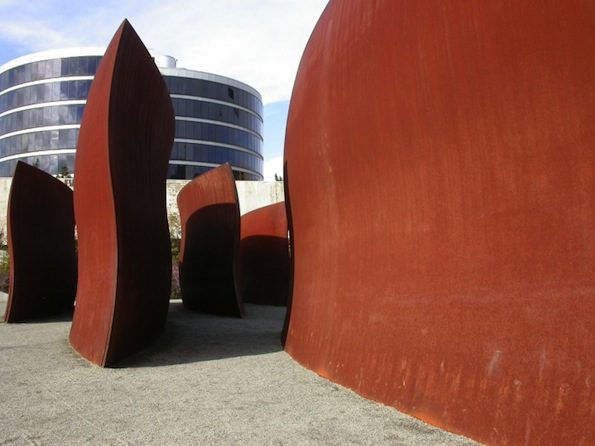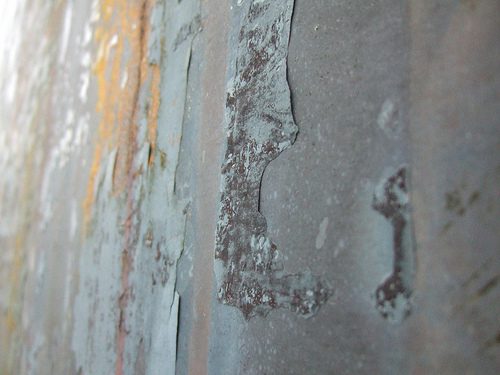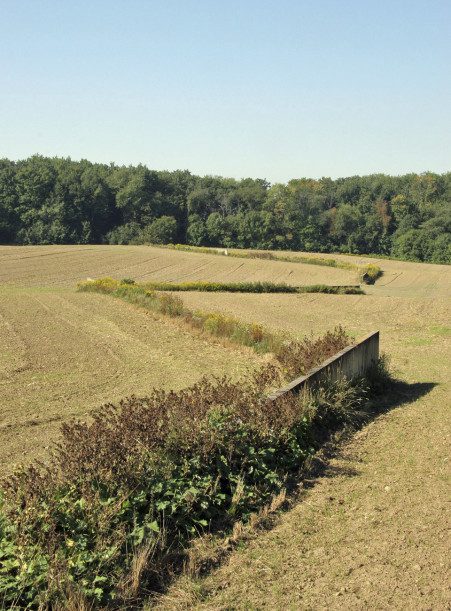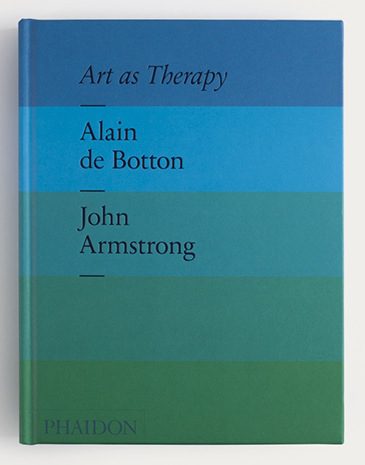A few years ago, I went to New York City for the Easter long weekend. Our group, four of us, stayed with an acquaintance and his girlfriend in their small one bedroom in the Bronx and because we couldn’t quite fit comfortably in the living room at the same time, he took us on a tour of his neighbourhood after we’d dropped off our things. We walked underneath the Hell Gate Bridge and then wound through factories, empty broken asphalt streets, and shipping yards in the nearby industrial area, everything curiously quiet compared to the unceasing Manhattan noise I was used to. Halfway through our host stopped and pointed out some gigantic curved steel plates sitting just beyond a chain link fence. They appeared to be scrap metal: rusting, abandoned objects that might’ve once had a greater purpose—machinery gears, factory foundations? But they were actually part of something completely different: a Richard Serra sculpture. The plates were going to be shipped to whoever had commissioned them, but there had been some kind of delay and until it was sorted out they were in storage in front of us. It wasn’t exactly a finished sculpture, but now that I’m familiar with Serra’s work, I can say it was undeniably created by him. You don’t really think about the logistics of moving his monolithic sculptures until you see one in a shipping yard in the South Bronx, uncovered because they’re designed to withstand the elements and unguarded because they’re too heavy to steal.
Once I learned Serra’s name, he popped up everywhere. Toronto’s Pearson airport has one of his sculptures, Tilted Spheres, in Terminal One. Four slabs of steel curl upwards like the petals of a gigantic mechanical tulip, big enough for passengers waiting for their flights to walk through and look up at. The sculpture was installed before the terminal was built; it would’ve been too complicated to do it afterwards. I saw Wake while on vacation in Seattle. It’s outdoors in the Olympic sculpture park by the Pacific Ocean, where the oxidized slabs sit upright, but they’re wavy as if a gust of wind blew by just as the molten steel solidified.

I recently came across Richard Serra again, this time in Alain de Botton and John Armstrong’s book Art as Therapy. It’s a hardcover coffee-table Phaidon edition, the kind of book I usually think is too unwieldy to buy, but the striped bluey-turquoise cover art was soothing and—I realized when I saw it in the bookstore—I was in need of some kind of therapy. I bought it and took it home.
The book proposes that art is “a therapeutic medium that can help guide, exhort and console its viewers, enabling them to become better versions of themselves.” Art, according to de Botton and Armstrong, is elevated in a way that makes it unnecessarily mysterious and inaccessible. It’s not a new criticism, but the book aims to provide a concrete way of making it more helpful, more useful, to the public. Maybe if art’s potential therapeutic function were emphasized, people wouldn’t feel a glum obligation to visit a gallery; they would want to go. The book identifies seven psychological “frailties”—remembering, hope, sorrow, re-balancing, self-understanding, growth, and understanding—and then, like a drug prescription, offers up various pieces of art as antidotes or vitamins. There’s even a revised floor plan for the Tate Modern where the floors are organized in a Maslowesque hierarchy starting with a “Gallery of Suffering” and ending with a “Gallery of Self-Knowledge.”
I flipped first to the section on sorrow. “One of the unexpectedly important things that art can do for us is teach us how to suffer more successfully,” de Botton writes. I had the nagging suspicion that my current method of dealing with sorrow (crying in the car on my drives to work, playing endless rounds of Candy Crush in bed at 7 p.m.) was not the most dignified way to go about it. The notion that there was a better, more successful way to manifest this feeling intrigued me. De Botton has broached this topic before: his book How Proust Can Change Your Life has an entire chapter on successful suffering, using Proust’s life and writing as lessons.

Serra’s sculpture Fernando Pessoa clarifies his point. “Serra’s work does not deny our troubles; it doesn’t tell us to cheer up. It tells us that sorrow is written in the contract of life. The large scale and overtly monumental character of the work constitute a declaration of the normality of sorrow.” Art, de Botton wants to demonstrate, helps prove the universality of emotions. It’s not so much that there’s a wrong or right way to suffer, but that when you’re deep in it, it’s useful to be reminded that what you’re feeling isn’t unique. Misery loves company, sure, but misery also loves representations of sadness sublimated in a way that gives dignity to the strangeness of the feeling. There’s certainly something somber and resolute about Serra’s sculptures, and about Fernando Pessoa in particular, which is composed of a single rectangular rigid steel plate. It makes sense that his work could be a visual stand-in for the towering, engulfing feelings of sorrow.
Reading about Serra in Art as Therapy reminded me that there was another sculpture of his nearby that I’d never seen: Shift, a large-scale concrete installation created in the early seventies in a farmer’s field in King City, Ontario. I couldn’t see Fernando Pessoa in person, but I could see this, so my husband and two friends of ours set out to find it. It’s not on any official museum grounds, but you can see it on satellite maps and recently a new housing development street was named Richard Serra Court, so we had an idea of where to go.
We drove forty minutes outside of Toronto, turned left onto Sculptor’s Gate, and then arrived on Richard Serra Court. While developments tend to be named after what was razed to replace with houses, Serra’s sculpture remains stubbornly standing. The company that purchased the land from the original owner tried to remove it—imagine all the houses you could build there!—but after community outcry, Shift was finally granted protection under the Ontario Heritage Act in 2013.
The streets and houses were in various stages of construction and we circled around the snowy, slushy development unsure of where to stop. Serra never intended for Shift to be easily accessible by the public, so we went to the presentation house to ask about the easiest entrance point. Why else name a street after him if you didn’t want to bring attention to the fact that the sculpture existed? The real estate agent inside sighed and sized up our boots and coats. “It’s very difficult to get to,” she said. “And it’s just a cement wall.” She warned us of “hungry coyotes” but in the end admitted that she couldn’t technically prevent us from visiting and showed us where it was on the development map. On paper it’s on a large swath of green next to the neat geometric lines of residential streets.
We got back in the car and parked closer to Shift’s location. A chain link fence surrounded the entire development (to keep the coyotes out?), so we hopped over. It was the third day of spring, but everything was still wintry and there were no footprints in the field ahead of us. We soon realized it was because the snow came up to our knees. We walked in a single file in each other’s deep footprints, not sure if we were going the right way, sometimes toppling over in a deep patch of snow. If there were coyotes, our intermittent shrieks must have scared them away. It wasn’t a long hike, but the snow made it feel like work, and when we finally got there it felt like we’d discovered something.
The sculpture, six long cement walls stretching out over thirteen acres, was half-buried. We climbed on to the nearest wall since it was easier than trudging through the drifts. But it was hard to resist playing in the snow. There’s a video of my best friend and me holding hands, counting to three, and then jumping into the thigh-deep snow as if it were a lake. Eventually the four of us sat on the wall to catch our breath, our legs dangling over the side. When the sun came out we watched a band of light move across the field, stark white except for the zigzag of the sculpture.
In the section about “hope” in Art as Therapy, de Botton writes, “Today’s problems are rarely created by people taking too sunny a view of things; it is because the troubles of the world are so continually brought to our attention that we need tools that can preserve our hopeful dispositions.” As an example of such a tool he presents Matisse’s Dance (II), the popular painting of nudes dancing in a circle, its blue and green background matching the book cover’s color scheme I was drawn to at the store. “The dancers in Matisse’s painting are not in denial of the troubles of this planet, but from the standpoint of our imperfect and conflicted—but ordinary—relationship with reality, we can look to their attitude for encouragement.” This is true, but as we looked out at Shift, I thought about how it could be used as an example of hope instead—a reminder that while things might start off bad, they can also improve. I’d been reminded of Serra’s work when I bought a book because I was feeling bad, but when I saw him again, I felt better and would, hopefully, keep feeling better. This sculpture, like so many of Serra’s large-scale works, even Fernando Pessoa, would still be standing in a few months. Even though Shift’s concrete walls were slightly crumbled, they were solid, permanent.

Art as Therapy uses a straightforward, immediately graspable framework to approach the occasionally impenetrable subject of art. “The more difficult our lives the more a graceful depiction of a flower might move us,” de Botton writes, and while he’s right, it’s the mutability, the ability of art to mean different things at different times, that’s missing from Art as Therapy. My experiences with Serra’s work were far from sorrowful: the thrill of finding him within the first few hours of driving into New York City; on a sleepy morning in the haze of summer vacation; with loved ones on one of the last days of winter. He pops up in the Vampire Weekend song “White Sky” where they evoke a “Richard Serra skatepark” in the Museum of Modern Art, and whenever I hear that song, I imagine how fun it would be use the steel slabs as ramps, what the scrape of wheels would sound like on them.
The problem with art is not so much that people don’t know what to think about it, but that they’re afraid what they’re feeling is the wrong thing. As part of an upcoming exhibit at the Art Gallery of Ontario and other galleries around the world, de Botton and Armstrong will curate pieces in line with Art as Therapy, and I wonder if organizing them so that the hopeful pieces of art are clearly delineated from the sorrowful ones will cause further anxiety. What if you don’t feel the right way, even after you’re told?
“From the top of the hill, looking back across the valley,” Serra said about the experience of walking along Shift’s walls, “Images and thoughts are remembered which were initiated by the consciousness of having experienced them.” Feelings and thoughts change, but a piece of art is a static marker. What feels like a monument to something difficult one day can change the next time you see it, and how wonderful to feel so many different things over a span of time, to allow yourself the privilege to decide for yourself.






One response
i really enjoyed this. “…to allow yourself the privilege to decide for yourself.” thank you. there’s a therapeutic side to creating art, too.
Click here to subscribe today and leave your comment.